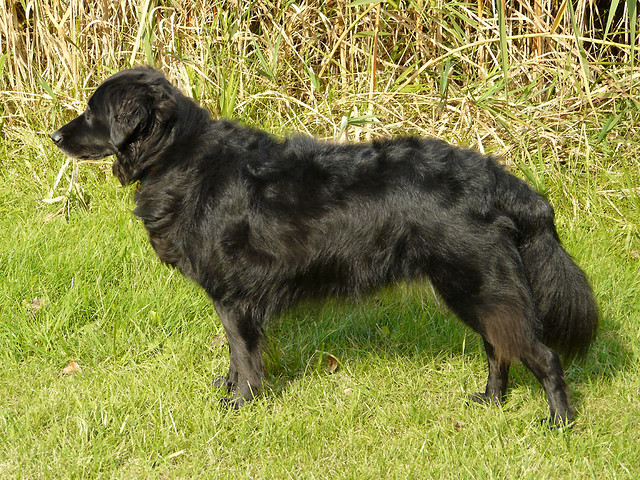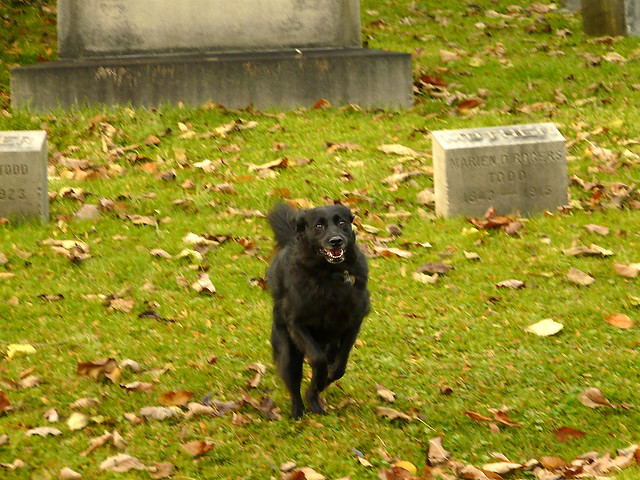
Wednesday, October 27, 2010
Wednesday, October 20, 2010
Bad dog!
 Dahlia is, normally, a good dog. No, wait, normally she's a very good dog. She doesn't destroy things. She doesn't get into things while we're gone. She's friendly and calm and sweet. We can leave her alone in the house for a few hours with no problems.
Dahlia is, normally, a good dog. No, wait, normally she's a very good dog. She doesn't destroy things. She doesn't get into things while we're gone. She's friendly and calm and sweet. We can leave her alone in the house for a few hours with no problems.But, like all creatures, she has her downfall. That downfall is, of course, butter.
Yes that's right...butter. That lovely, creamy, slightly salty substance that one would never imagine a dog could go ga-ga for. But Dahlia does. Which is why we try so very hard to put it away.
Last week, however, things didn't quite go as planned. My partner cooked his breakfast and in his rush to leave the apartment to go to work, forgot to put it away. This was, of course, exactly what the Butter Bandit was waiting for!
At some point during the 5 hours she was left home alone, she stole the butter. Now, could she simply take it to the living room and eat it? No. That would be too easy for the Butter Bandit!
Instead, she took it into our bedroom and got on our (unmade) bed. Somehow during all of this, she managed to cut her nose. She cuts it every single time she steals the butter (which, according to photographic evidence, is about once every 6 months). She then proceeds to track bloody paw prints all over the bed. We found blood on both the top and bottom sheet and on all four pillows. I have no idea what she did. It's like she had a big butter-stealing party all by herself and raced all over the bed with her prize.
Our guess is that she cuts her nose in the attempt to remove the butter from the wrapper, which she is never successful at. She ultimately ends up chewing some out of the side of it and then hiding it deep beneath my pillow. When we arrive home, the cut on the nose is the first indication that something bad happened while we were out.
She is never punished. It's our fault, after all, that the butter-stealing happened. Instead, the butter is thrown out, the sheets changed, and Dahlia is given something more appropriate to chew on as she has to wait until the clean-up occurs before going on a walk.
So is my dog a bad dog? No, not exactly. But she certainly has her moments!
Wednesday, October 13, 2010
Tuesday, October 12, 2010
Agility photos
This weekend was beautiful. Temperatures near 60, sunny. It was the perfect day to take Dahlia out and get some photos of some of her new agility moves. I only have one jump (which I bought from Affordable Agility) and a cheap tunnel (which I got off eBay for a whopping $24!), but that was enough for some good photos. As the person who has been working with Dahlia in agility class, I ran her through the jumps and tunnels. Photos were taken by my partner.
The first thing I did was to set Dahlia up in front of the jump. I turned around and saw THIS look. I'm so glad we got a photo of it. Some people thought this look was disgruntled. But it's not. It's her happy excited, something fun is going to happen crooked "Elvis grin." I often get it when I pull out treats or grab a tug toy to play with.
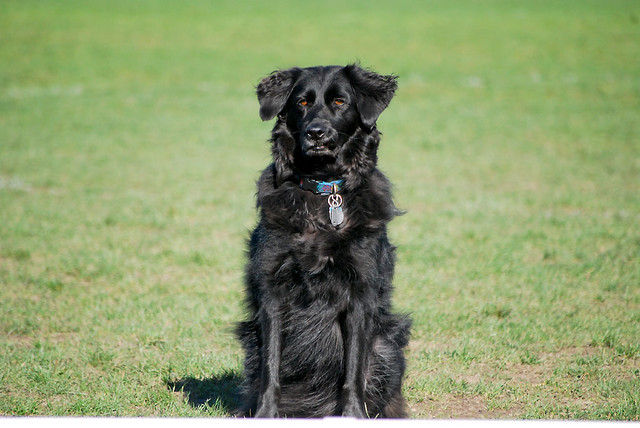
(The bottom looks kind of weird and crooked because one of the bars of the jump was there.)
Dahlia looks up at me while I get her into position.
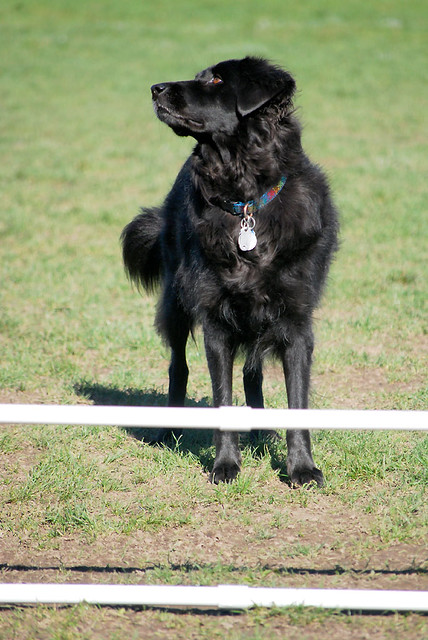
We started with the bar fairly low. She had to jump, but it wasn't a huge jump.
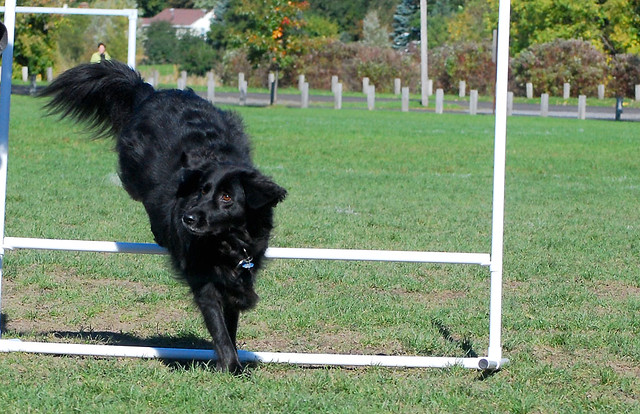
She cleared it rather easily.
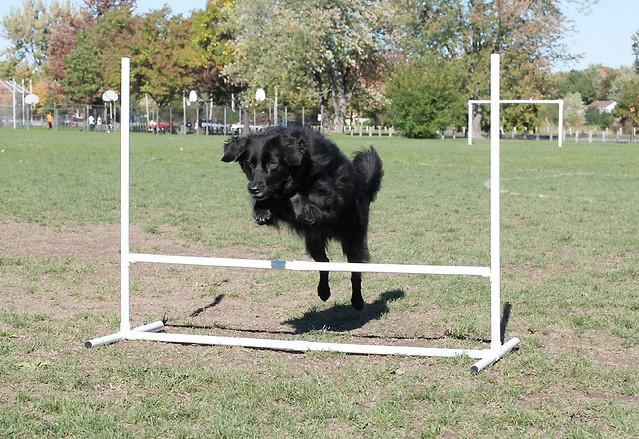
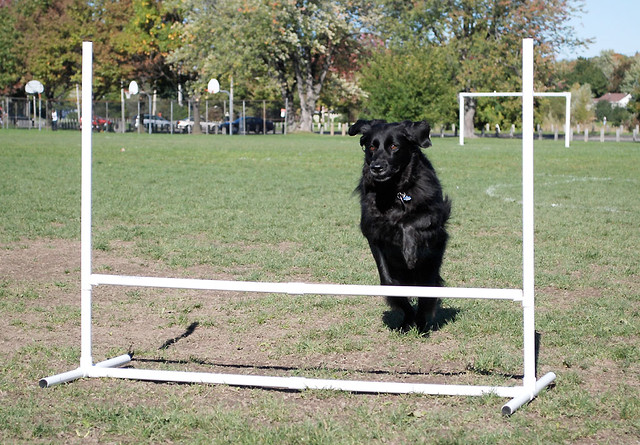
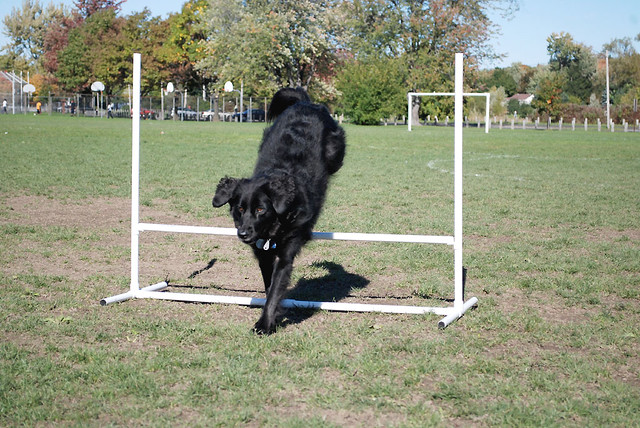
So then we raised it up quite a bit. As you can see, she cleared THAT rather easily too. Go Dahlia!
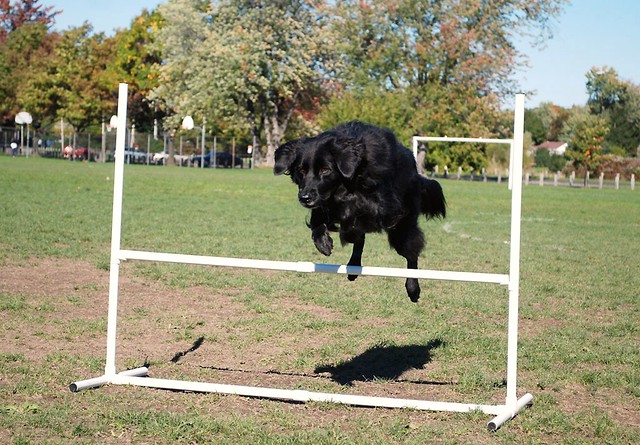 >
>
Then we pulled out the tunnel. It can extend to 18 feet and bend, but we're not quite ready for it to bend just yet, so we left it out mostly extended and straight.
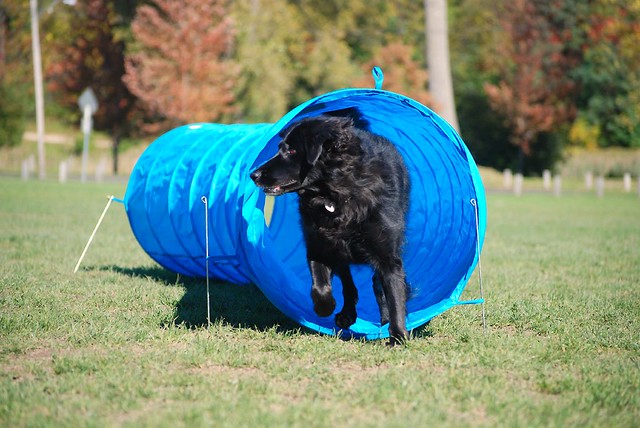

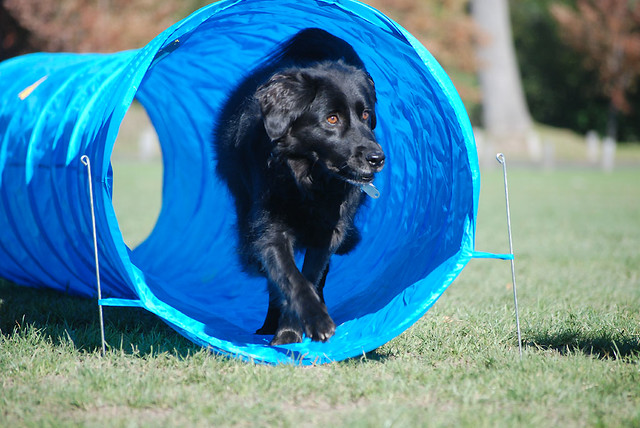
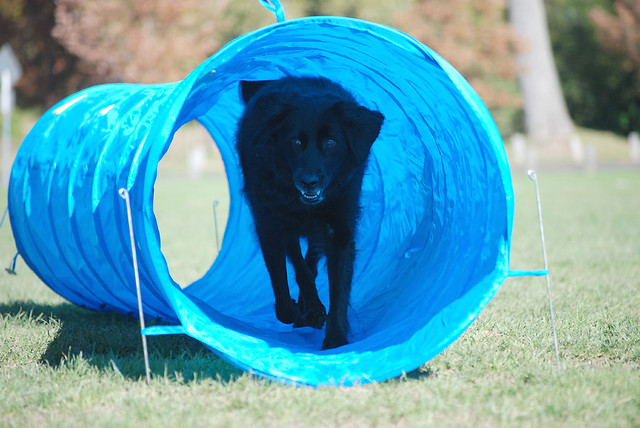
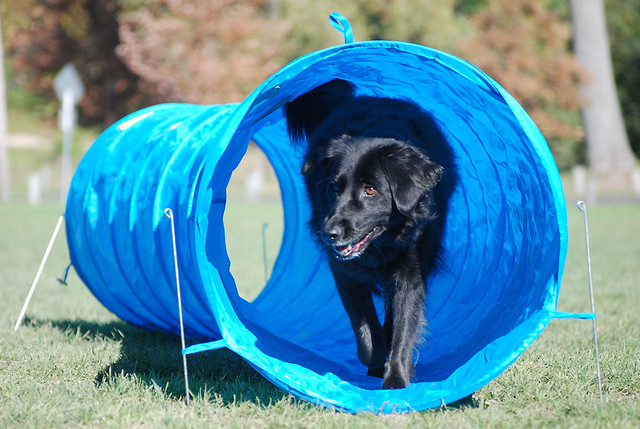
We went back to the jump for one last try.
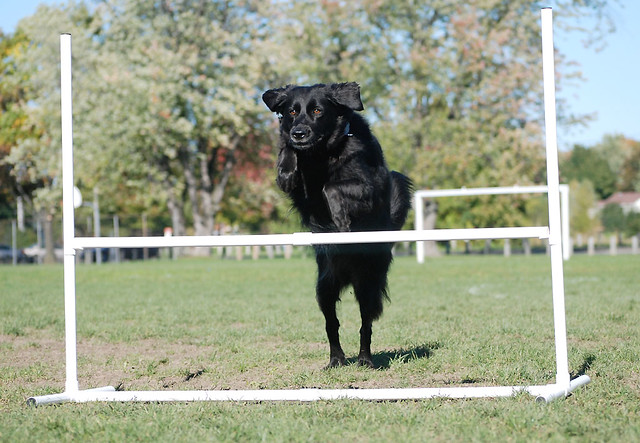

And then got this!
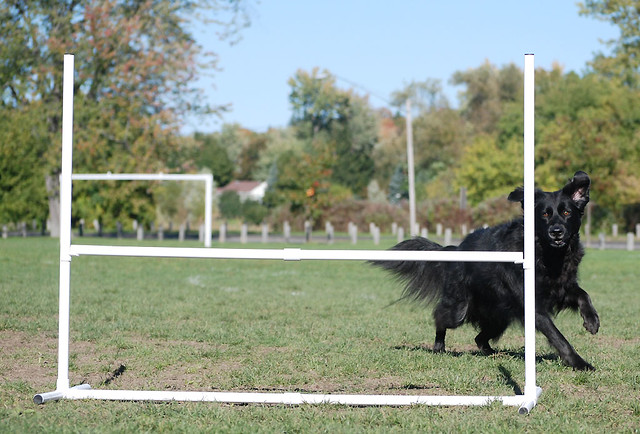
Awww Mom I'm tired.

After that, she just basically collapsed into a puddle of Dahlia and we packed up and headed home.
The first thing I did was to set Dahlia up in front of the jump. I turned around and saw THIS look. I'm so glad we got a photo of it. Some people thought this look was disgruntled. But it's not. It's her happy excited, something fun is going to happen crooked "Elvis grin." I often get it when I pull out treats or grab a tug toy to play with.

(The bottom looks kind of weird and crooked because one of the bars of the jump was there.)
Dahlia looks up at me while I get her into position.

We started with the bar fairly low. She had to jump, but it wasn't a huge jump.

She cleared it rather easily.



So then we raised it up quite a bit. As you can see, she cleared THAT rather easily too. Go Dahlia!
 >
>Then we pulled out the tunnel. It can extend to 18 feet and bend, but we're not quite ready for it to bend just yet, so we left it out mostly extended and straight.





We went back to the jump for one last try.


And then got this!

Awww Mom I'm tired.

After that, she just basically collapsed into a puddle of Dahlia and we packed up and headed home.
Friday, October 8, 2010
The HSUS Pet of the Week!
Dahlia is going to be the Humane Society of the United States's Pet of the Week this week. If you already receive their newsletter, watch for her! If you don't, you can sign up to receive it here.
I'm very excited to have my girl featured!
I'm very excited to have my girl featured!
Adopting from a shelter, Part III: How did Dahlia fit with my plan?
I promised a third blog post on how Dahlia fit with my three-part list that I had made up prior to getting a dog.
Things I must have in a dog
So how did we do? 6 out of 6. Excellent!
So really? Not bad at all. She has a few of the "can work on this" behaviors but fits much of the profile we were looking for.
As for the last list? Dahlia has none of the things I knew I couldn't deal with in a dog.
So is Dahlia the perfect dog? Of course not. She has her issues (one of which is stealing butter every chance she gets), but she fit in almost perfectly with what we were looking for in a dog. And we couldn't be happier with her.
I hope everyone who goes to a shelter or a rescue finds a dog that they feel this happy about!
Things I must have in a dog
- Size: Medium (30-60 pounds) ► Dahlia is 50 pounds.
- Coat: Long hair ► Dahlia is long-haired
- Behavior: People friendly ► Dahlia absolutely adores people and greets them all nicely.
- Behavior: Active enough to go on long hikes ► Absolutely
- Behavior: Rides well in the car as we like to drive to plenty of places to go hiking ► This was one of the first things I noticed about her. Since I met her on a transport, I had her in the car for over an hour. She settled down in the back seat and slept the whole way.
- Behavior: Affectionate ► Absolutely. This dog lives for belly rubs.
So how did we do? 6 out of 6. Excellent!
Things I can deal with/bend on/work on
- Breeds: Prefer Herding dogs or Retrievers or mixes of those breeds, but willing to step outside that idea (especially to dogs like Poodles or Huskies) ► Dahlia is a mix of Border collie and some sort of retriever. If I want to be totally honest with myself, I was unsure about getting a Border collie mix but it turns out that they are absolutely the dogs for me.
- Color: Would prefer a black dog as they have the hardest time getting out of shelters, but willing to adopt a dog of any color ► Dahlia is black.
- Age: Prefer 1-3 years old, but could get a somewhat older dog ► Dahlia was 2 to 2 1/2 years old when we adopted her.
- Gender: Prefer female dogs, but would be willing to get a male dog ► Dahlia is female.
- Behavior: House training issues ► Dahlia has no house training issues. She never had an accident in our place.
- Behavior: Jumping/mouthing/chewing/general "unruly" behavior ► Dahlia did not jump on people and her only "unruly" behavior was a nipping at our heels when we ran away from her. That was quickly stopped.
- Behavior: Dog aggression (I would prefer a dog friendly dog, but could work with a dog on this) ► Dahlia is not dog aggressive at all.
- Behavior: Afraid of children (We have none and will not have any, so this is not a huge deal, would work on it nonetheless) ► Dahlia is not afraid of children and, in fact, adores them. She's quite popular with the kids in our neighborhood.
- Behavior: Poor leash manners ► Dahlia was leash reactive when we first got her. This issue has been worked on and she's mostly good.
- Behavior: Bolting out the door ► Dahlia did bolt out the door once, but not to gain her freedom. She wanted to stick by our side. It was seeing this that made us think she could be good off leash. She is.
- Behavior: Mild fears and sound sensitivity issues ► Dahlia is noise-sensitive and has some threshold issues. She is afraid to go into some places, like our bathroom, for absolutely no reason and she has issues with going into places where things have scared her before (like the back of Petsmart because she had a bad experience with a groomer there). All of this is manageable.
- Behavior: Digging ► Dahlia is not much of a digger, but will dig a hole under bushes in the heat.
- Behavior: High prey drive ► Dahlia has a low to middle prey drive. She will chase squirrels, geese, ducks, and other small animals, but can be called off of these chases. She does not see cats or small dogs as prey.
- Medical issues: Diabetes (my partner is diabetic; we're used to diabetes in our household) ► No.
- Medical issues: Deaf (we would be comfortable adopting a deaf dog) ► No.
- Medical issues: Epilepsy ► No.
- Medical issues: Skin issues/allergies ► Dahlia has issues with chicken-based products. While not easily avoided, we have managed to do so.
- Medical issues: Mange (we have no other pets so there would be no need to quarantine; we would be happy to help a dog heal from this) ► No.
- Medical issues: Three legs ► No.
So really? Not bad at all. She has a few of the "can work on this" behaviors but fits much of the profile we were looking for.
As for the last list? Dahlia has none of the things I knew I couldn't deal with in a dog.
So is Dahlia the perfect dog? Of course not. She has her issues (one of which is stealing butter every chance she gets), but she fit in almost perfectly with what we were looking for in a dog. And we couldn't be happier with her.
I hope everyone who goes to a shelter or a rescue finds a dog that they feel this happy about!
Wednesday, October 6, 2010
Adopting from a shelter, Part II: My plan
Now, I will begin this with a bit of a caveat: In the end, I did not get my dog directly from a shelter. I had a list of shelters in hand, ready to head to as soon as I was ready to adopt a dog. I had been looking at dogs on petfinder.com for ages. And then I went on a transport and met a dog who was traveling from a shelter to a rescue and realized I had found the right dog.
So with that in mind, here was the list I had come up with prior to finding Dahlia:
Things I must have in a dog
A couple things to note: (1) This list is clearly not comprehensive. There are many other behavior and medical issues one might come across with dogs in a shelter or rescue. But these are either common issues or ones I took into consideration as I was making the list. (2) My list of what I "must have" is fairly small. My list of things I can bend on is the largest and my list of things I can't deal with is fairly large, but not as big as the middle list.
All of this was carefully considered before I even met Dahlia.
Coming up in the next post: How well does Dahlia fit with my original list?
So with that in mind, here was the list I had come up with prior to finding Dahlia:
Things I must have in a dog
- Size: Medium (30-60 pounds)
- Coat: Long hair
- Behavior: People friendly
- Behavior: Active enough to go on long hikes
- Behavior: Rides well in the car as we like to drive to plenty of places to go hiking
- Behavior: Affectionate
Things I can deal with/bend on/work on
- Breeds: Prefer Herding dogs or Retrievers or mixes of those breeds, but willing to step outside that idea (especially to dogs like Poodles or Huskies)
- Color: Would prefer a black dog as they have the hardest time getting out of shelters, but willing to adopt a dog of any color
- Age: Prefer 1-3 years old, but could get a somewhat older dog
- Gender: Prefer female dogs, but would be willing to get a male dog
- Behavior: House training issues
- Behavior: Jumping/mouthing/chewing/general "unruly" behavior
- Behavior: Dog aggression (I would prefer a dog friendly dog, but could work with a dog on this)
- Behavior: Afraid of children (We have none and will not have any, so this is not a huge deal, would work on it nonetheless)
- Behavior: Poor leash manners
- Behavior: Bolting out the door
- Behavior: Mild fears and sound sensitivity issues
- Behavior: Digging
- Behavior: High prey drive
- Medical issues: Diabetes (my partner is diabetic; we're used to diabetes in our household)
- Medical issues: Deaf (we would be comfortable adopting a deaf dog)
- Medical issues: Epilepsy
- Medical issues: Skin issues/allergies
- Medical issues: Mange (we have no other pets so there would be no need to quarantine; we would be happy to help a dog heal from this)
- Medical issues: Three legs
Things I cannot deal with in a dog
- Size: Giant dogs (no dogs larger than approximately 80 pounds)
- Size: Small dogs (no dogs smaller than approximately 25 pounds)
- Breeds: No terrier/terrier mixes as they don't gel with my life; no short-faced dogs
- Age: No puppies!
- Age: No seniors...I'm well aware they need homes too but this is my first dog and I'm not ready for heartbreak so early on in getting him/her
- Behavior: Separation anxiety (I live in an apartment, this would be bad)
- Behavior: Fear aggression (my partner used to be afraid of dogs so this would be a bad mix)
- Behavior: Afraid of men (this dog is going to a home with a couple and again, with my partner being afraid of dogs I didn't want him to not bond with the dog right away)
- Behavior: Excessive barking (our landlord specified this one – if the dog is barking too much and neighbors complain we cannot keep the dog or have to move, so we need one who is not overly barky)
- Medical issues: Blind (my partner and I are too scattered with our musical instruments and books/papers from grading and class planning; it would be a poor home for a blind dog who needs things to stay where they are)
- Medical issues: Hip dysplasia (at a young age; obviously hip problems can happen when a dog is older, but would prefer to not adopt a dog who already has it)
- Medical issues: Heartworm (this can just be too heartbreaking to deal with; I couldn't deal with losing the dog so soon after getting it as the treatment can be rough)
A couple things to note: (1) This list is clearly not comprehensive. There are many other behavior and medical issues one might come across with dogs in a shelter or rescue. But these are either common issues or ones I took into consideration as I was making the list. (2) My list of what I "must have" is fairly small. My list of things I can bend on is the largest and my list of things I can't deal with is fairly large, but not as big as the middle list.
All of this was carefully considered before I even met Dahlia.
Coming up in the next post: How well does Dahlia fit with my original list?
Tuesday, October 5, 2010
Adopting from a shelter, Part I: Go in with a plan!
You have finally made the decision. You're going to get a dog! The first place you head out to is the local shelter and there you are confronted by dogs of all sizes and shapes.
A tiny older Chihuahua huddles in the back of his kennel, looking up at you with big eyes. "That one!" you think. "I would love a small lap dog."
In the next kennel, a young pit bull jumps up against the bars when you get close, his whole body wiggling with energy, his tail going a mile a minute, flashing you that great big bully smile. "That one!" you think. "I love his energy. I'd love to come home to that sort of excitement."
In the next kennel, a small Border collie mix is turning in circles, barking madly. She hasn't even noticed your arrival. "That one!" you think. "She has so much energy and she's beautiful!"
In a kennel further down sits an old Lab, her muzzle grey, her eyes rheumy. "That one!" you think. "She's so sad. She needs me."
Each of those faces, so very different from one another, are just some of the dogs you're likely to come across in a shelter. There are dogs of every size, breed, and mix in shelters in America. There are puppies, adults, and seniors alike, all looking for a great new home, all hoping you're going to be the one to take them home and love them for the remainder of their lives, whether it's 16 years or 6 months.
I will say this about shelters: It is very easy to fall in love there. But it is also very easy to fall in love with the wrong dog.
The wrong dog? you ask. Is that possible? How can any of those dogs be the wrong dog?
According to the ASPCA, "More than 20 percent of people who leave dogs in shelters adopted them from a shelter." 2 out of every 10 dogs left at a shelter were adopted from a shelter. Obviously some families believe they are the "wrong dog" and return them to the shelter.
So the question is, how do you walk into a shelter and find the right dog?
When I was looking for a dog I used an idea obtained from a counselor who worked with people trying to find out why they hadn't found "Mr./Mrs. Right." I found the idea worked just as well when looking for a dog as it did for a life partner of the human variety.
Take out a sheet of paper and divide it into three columns:
1. Things I absolutely must have in a dog.
2. Things I absolutely cannot deal with in a dog.
3. Things I would like/would not like but can bend on.
Items that go into these lists can include looks (size, coat color, coat length, etc.), breed or breed mixture, temperament (mellow, energetic, friendly, aloof, etc..), behavioral issues (fear, fear aggression, separation anxiety, jumping, mouthing, etc.), exercise requirements, animals or people the dog needs to be good with (good with children, other dogs, cats, etc.), medical issues (deafness, blindness, hip or elbow problems, diabetes, etc.), and anything else you consider to be pertinent to your life.
Once you begin to outline what you think the perfect dog for you and your family is, you'll have a much clearer picture of what you need and want. Finding a dog to meet your needs if you are overly specific may be difficult (though not impossible), so think hard about what you absolutely must have or must not have before putting them in those categories.
When you go into the shelter with this list in hand and talk to the workers about the dogs in the shelter, you may be less likely to go home with that 80 pound Shepherd mix when you really wanted a 10 pound lap dog.
In the next blog post, I will offer up my original list and let you see how it matches up with the dog I ultimately ended up with.
A tiny older Chihuahua huddles in the back of his kennel, looking up at you with big eyes. "That one!" you think. "I would love a small lap dog."
In the next kennel, a young pit bull jumps up against the bars when you get close, his whole body wiggling with energy, his tail going a mile a minute, flashing you that great big bully smile. "That one!" you think. "I love his energy. I'd love to come home to that sort of excitement."
In the next kennel, a small Border collie mix is turning in circles, barking madly. She hasn't even noticed your arrival. "That one!" you think. "She has so much energy and she's beautiful!"
In a kennel further down sits an old Lab, her muzzle grey, her eyes rheumy. "That one!" you think. "She's so sad. She needs me."
Each of those faces, so very different from one another, are just some of the dogs you're likely to come across in a shelter. There are dogs of every size, breed, and mix in shelters in America. There are puppies, adults, and seniors alike, all looking for a great new home, all hoping you're going to be the one to take them home and love them for the remainder of their lives, whether it's 16 years or 6 months.
I will say this about shelters: It is very easy to fall in love there. But it is also very easy to fall in love with the wrong dog.
The wrong dog? you ask. Is that possible? How can any of those dogs be the wrong dog?
According to the ASPCA, "More than 20 percent of people who leave dogs in shelters adopted them from a shelter." 2 out of every 10 dogs left at a shelter were adopted from a shelter. Obviously some families believe they are the "wrong dog" and return them to the shelter.
So the question is, how do you walk into a shelter and find the right dog?
When I was looking for a dog I used an idea obtained from a counselor who worked with people trying to find out why they hadn't found "Mr./Mrs. Right." I found the idea worked just as well when looking for a dog as it did for a life partner of the human variety.
Take out a sheet of paper and divide it into three columns:
1. Things I absolutely must have in a dog.
2. Things I absolutely cannot deal with in a dog.
3. Things I would like/would not like but can bend on.
Items that go into these lists can include looks (size, coat color, coat length, etc.), breed or breed mixture, temperament (mellow, energetic, friendly, aloof, etc..), behavioral issues (fear, fear aggression, separation anxiety, jumping, mouthing, etc.), exercise requirements, animals or people the dog needs to be good with (good with children, other dogs, cats, etc.), medical issues (deafness, blindness, hip or elbow problems, diabetes, etc.), and anything else you consider to be pertinent to your life.
Once you begin to outline what you think the perfect dog for you and your family is, you'll have a much clearer picture of what you need and want. Finding a dog to meet your needs if you are overly specific may be difficult (though not impossible), so think hard about what you absolutely must have or must not have before putting them in those categories.
When you go into the shelter with this list in hand and talk to the workers about the dogs in the shelter, you may be less likely to go home with that 80 pound Shepherd mix when you really wanted a 10 pound lap dog.
In the next blog post, I will offer up my original list and let you see how it matches up with the dog I ultimately ended up with.
Subscribe to:
Posts (Atom)



